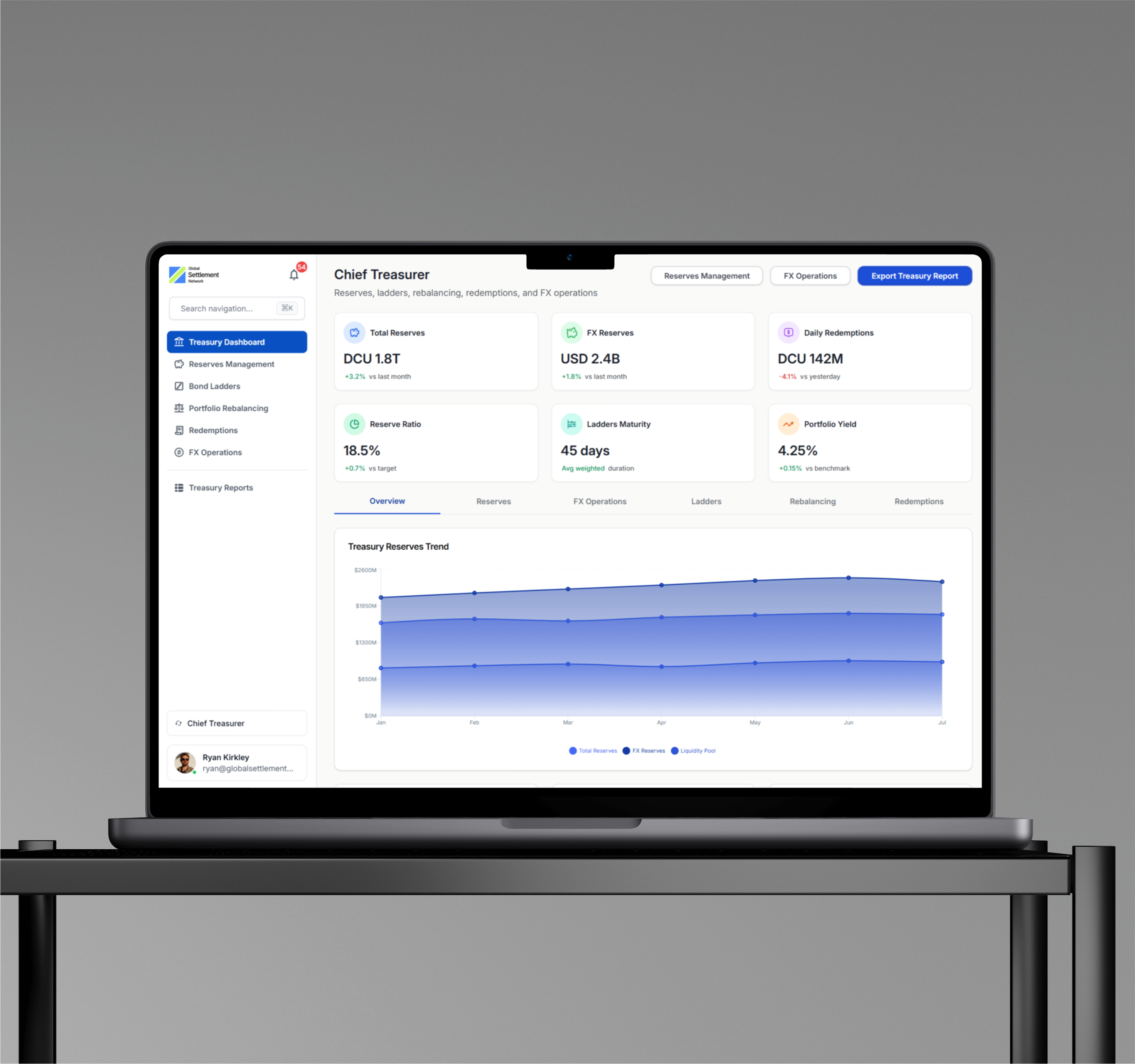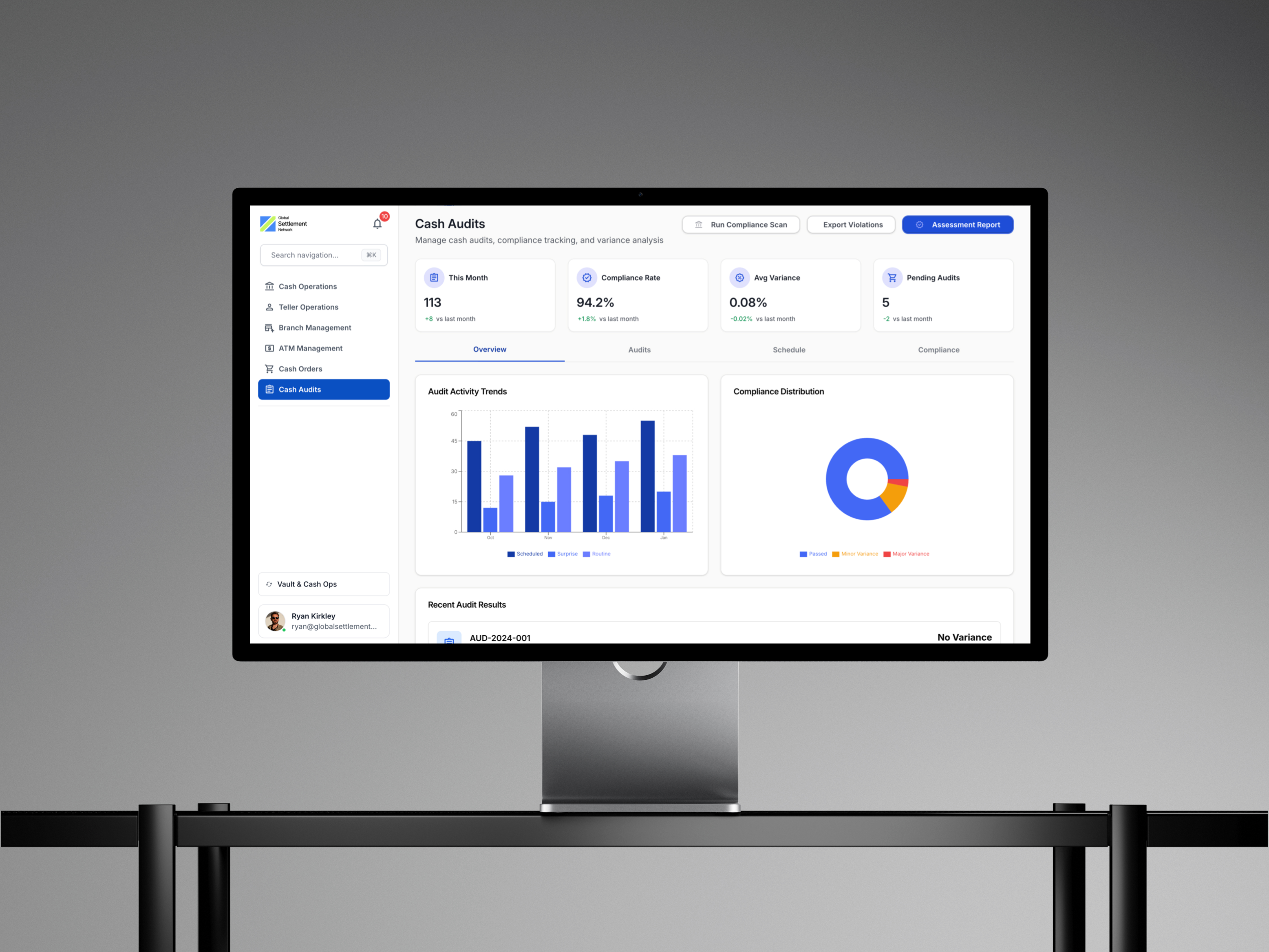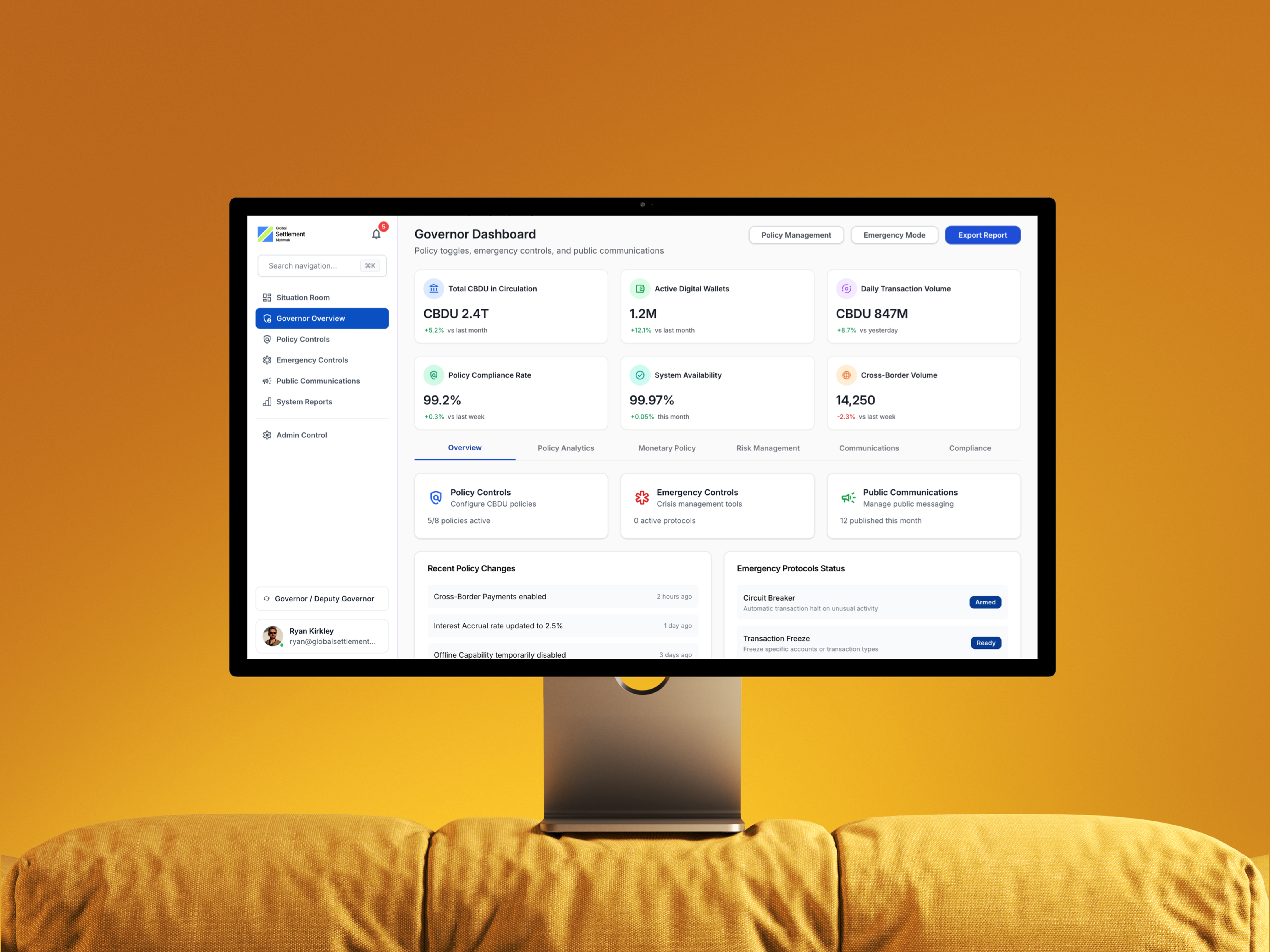<5s
Deterministic finality
View technical specs
Dual
Consensus mechanism (PoA+PoS)
Learn more
Zero
Bridge dependencies
See architecture
Why GSX for CBDCs
Built for central banks and financial institutions who demand enterprise-grade infrastructure with regulatory compliance at its core.
Compliance-first by design
Policy logic and KYC/AML are enforced before settlement. Attestations from permissioned Authority Nodes ensure transactions meet jurisdictional rules before PoS finalizes.
Finality and scale for FMI-grade workloads
Thousands of TPS targets with deterministic, BFT-style finality and 99.99% availability design goals, including failover and self-healing.
Interoperability without bridges
GSX natively writes settlement instructions to destination chains—no custodians, multisigs, or relayers; unified zk-proof audit trail.
How GSX Works
Explore the technical workflow that enables secure, compliant, and efficient cross-chain settlement without traditional bridge dependencies.
Lock/Burn on source
Initiate the transaction by locking or burning tokens on the source chain (e.g., domestic CBDC ledger). This ensures the total supply remains consistent across chains.
Compliance & Access (GSX PoA)
KYC, jurisdiction, and origin metadata are enforced through GSX's Proof of Authority consensus. Only authorized nodes can validate compliance requirements.
Proof generation (ZK)
Generate zero-knowledge proofs to validate transaction validity without exposing private data, ensuring privacy while maintaining regulatory compliance.
Finalization (GSX PoS)
ZK-augmented Byzantine Fault Tolerant finality through GSX's Proof of Stake consensus mechanism ensures deterministic settlement with cryptographic guarantees.
Native write to target chain
Mint or credit tokens directly on the destination chain without requiring bridges, custodians, or intermediaries. Direct settlement instructions are written natively.
Admin & Sandbox
Experience GSX's compliance-first administration tools through our interactive demo environment.
Request Sandbox Access
Get hands-on access to GSX admin tools.
Qualified government and bank teams typically receive access within 24 hours.

Government rollout: a safe, phased path
A structured three-phase approach with clear exit criteria and regulator touchpoints for secure CBDC deployment.
Implementation Timeline
Phased deployment with clear milestones and exit criteria
1
Phase 1 — Sandbox/PoC
Months 0–6Issue test CBDC, basic PvP settlements, RTGS gateway stub integration, and compliance runbook development. Establish foundation for controlled testing environment.
2
Phase 2 — Limited live pilot
Months 6–24Deploy low-volume interbank and FX corridors with comprehensive SLA monitoring, regular stress testing drills, and formal legal opinion gathering.
3
Phase 3 — Production rollout
24+ monthsScale to broader participant network with 24/7 operational capabilities, formal rulebook implementation, and regular resilience exercises.
Key Benefits
Risk mitigation through gradual scaling
Continuous regulator engagement and feedback
Proven exit criteria for each phase
Implementation Checklist
Essential components for secure CBDC deployment
Policy controls
Transaction limits, jurisdiction rules, and compliance enforcement mechanisms
Audit trail
Comprehensive logging, immutable records, and regulatory reporting capabilities
Data localization options
Configurable data residency and cross-border data handling requirements
Rulebook & legal enforceability
Legal framework alignment and regulatory compliance documentation
SLA targets
Performance guarantees, uptime commitments, and operational excellence metrics
Bank integration blueprint
Enterprise-grade integration architecture with secure APIs, real-time events, and standards compliance.
Integration Architecture
Core banking system integration with GSX gateway
Core Banking
Legacy Systems
REST/gRPC API
GSX Gateway
API Layer
ISO 20022/SWIFT
Message Mapping
Protocol Adapter
Event Stream
Event Listeners
Real-time
Updates
Treasury
Position Mgmt
GL Entries
General Ledger
Accounting
Integration Flow
Secure, bi-directional communication with HSM-backed authentication and real-time event processing
GSX Transaction API Example
POST /v1/gsx/transactions
Content-Type: application/json
Authorization: Bearer eyJhbGciOiJSUzI1NiIsInR5cCI6IkpXVCJ9...
{
"transaction_id": "txn_2024_001_cbdc_001",
"source": {
"account": "central_bank_reserve_001",
"currency": "USD-CBDC",
"amount": "1000000.00"
},
"destination": {
"account": "commercial_bank_settlement_002",
"currency": "USD-CBDC",
"amount": "1000000.00"
},
"metadata": {
"iso20022_message_id": "PACS.008.001.10",
"instruction_reference": "INST20240115001",
"settlement_method": "CLGS",
"priority": "HIGH",
"regulatory_reporting": {
"jurisdiction": "US",
"reporting_party": "FED_NY_001"
}
},
"compliance": {
"kyc_verified": true,
"aml_cleared": true,
"sanctions_checked": true,
"policy_attestation": "PoA_NODE_001_SIGNATURE"
},
"signature": "MEUCIQDxxxxxxxxxxxxx...REDACTED...xxxxxxxxxxxxx"
}Sensitive Data
JSON Schema
HSM Signed
Integration Features
Enterprise-ready capabilities for secure bank connectivity
HSM-backed keys
Hardware security modules ensure cryptographic key protection and transaction signing
Webhook events
Real-time notifications for transaction status, settlements, and compliance updates
Message bus integration
Enterprise message queue compatibility for reliable, asynchronous processing
ISO mapping adapters
Seamless translation between ISO 20022, SWIFT MT, and proprietary bank formats
Security & Compliance
All communications are encrypted end-to-end with HSM-backed digital signatures. Full audit trails and regulatory reporting ensure compliance with local and international banking standards.
Security & performance
Enterprise-grade performance metrics with deterministic finality, proven availability, and elastic scaling capabilities.
Deterministic finality (BFT): seconds
Byzantine fault tolerant consensus ensures immediate, irreversible transaction finality without probabilistic confirmation delays.
High availability target 99.99%
Redundant nodes with automatic failover and geographic distribution ensure continuous operation with minimal downtime.
Elastic scaling; stress-tested to 10× bursts
Dynamic throughput scaling handles traffic spikes and market volatility with proven resilience under extreme load conditions.
Dual consensus: PoA (policy) + PoS (finality)
Proof of Authority enforces compliance and regulatory policy while Proof of Stake provides decentralized economic finality.
Performance & Availability Citations
Performance: Deterministic BFT finality with 2-3 second block times and <5s P95 SLA targets.Availability: 99.99% uptime through redundant validator distribution and automated failover.Scaling: Elastic throughput from 2,000+ TPS base to 10× burst capacity under stress testing.Consensus: Hybrid PoA/PoS architecture separating policy enforcement from economic finality.
Technical Specifications
Detailed performance metrics and system architecture
Governance & compliance
Public‑permissioned governance for FMIs: a Council of reputable institutions with on‑chain voting for upgrades; central banks hold meaningful sway on systemic matters.
2-Tier Governance Model
Supervisory oversight with decentralized execution
Supervisory Layer (PoA)
Policy Enforcement & Compliance
Council Governance
Reputable institutions with on-chain voting rights
Central Bank Authority
Meaningful influence on systemic policy matters
Compliance Enforcement
KYC/AML and jurisdictional rule validation
Emergency Powers
Reversible measures under strict legal conditions
Governance Flow
Policy decisions → Network execution
Main Chain (PoS)
Decentralized Settlement & Finality
Economic Consensus
Stake-weighted validation and block production
Immutable Settlement
Cryptographic finality without governance override
Network Operations
Validator set, staking rewards, and slashing
Protocol Upgrades
Technical improvements via Council approval
Policy parameters
Compliance rules
Emergency procedures
Validator criteria
Protocol upgrades
Transaction finality
Cryptographic proofs
Settlement mechanics
Core consensus
Stake slashing
Governance Separation
Policy decisions are made by institutional governance while settlement finality remains cryptographically immutable and economically secured.
Governance Framework
Professional oversight and legal certainty for institutional confidence
Advisory Board for Public Sector
Senior experts from central banking, financial regulation, and international monetary policy providing strategic guidance on CBDC implementation and cross-border coordination.
Emergency Measures Framework
Reversible emergency powers exercised only under strict legal conditions with mandatory judicial review and automatic sunset clauses to prevent abuse.
Rulebook Under Neutral Law
Established legal frameworks providing regulatory certainty
New York Law
Neutral LawEstablished commercial law precedents
Strong contract enforcement mechanisms
International arbitration compatibility
Regulatory clarity for financial institutions
Cross-border dispute resolution frameworks
English Law
Neutral LawMature common law system
International financial services expertise
Sophisticated regulatory architecture
Global arbitration center recognition
Fintech-friendly legal innovations
Legal Safeguards & Accountability
All governance actions are subject to established legal frameworks with clear appeal processes, mandatory transparency requirements, and institutional accountability mechanisms to ensure responsible exercise of emergency powers.
Policy Trust Framework
Institutional Confidence
GSX combines institutional oversight with cryptographic immutability, ensuring that policy decisions are made by qualified authorities while settlement mechanics remain tamper-proof. This dual-layer approach provides the regulatory certainty that central banks require while maintaining the technical integrity that makes blockchain settlement reliable.
Democratic Governance
Council voting ensures no single institution controls network policy, while central bank authority addresses systemic risk concerns.
Immutable Settlement
Once transactions achieve cryptographic finality, they cannot be reversed through governance, ensuring settlement certainty for all participants.
Case studies & scenarios
Real-world implementation scenarios demonstrating GSX's capabilities for central banks and financial institutions.
National CBDC on GSX
Cross-border Settlement
eNaira ↔ SGD corridor concept demonstrating PvP/FX rules and token policy carried cross‑border with native interoperability.
Real-time PvP settlement between central banks
Cross-border FX rules enforcement
Token policy portability across jurisdictions
Native write to destination chains
Regulatory compliance automation

Private Bank Tokenization & DvP
Instant Settlement
Atomic delivery vs payment on a single ledger enabling instant settlement for tokenized assets and securities.
Atomic DvP settlement mechanics
Single ledger for all participants
Instant finality for tokenized assets
Programmable settlement conditions
Reduced counterparty risk

Government Outcomes
Measurable benefits for central banks and financial institutions
Cost Savings
Improvement
60-80%
Reduction in cross-border settlement costs compared to traditional correspondent banking networks
Financial Inclusion
Improvement
2.5B+
Unbanked and underbanked populations gaining access to digital financial services
Transparency
Improvement
100%
Real-time visibility into transaction flows and settlement status for regulatory oversight
FX Liquidity
Improvement
24/7
Continuous foreign exchange markets with instant settlement and reduced counterparty risk
Asset Tokenization
Improvement
Trillions
New asset classes and investment opportunities through programmable digital assets
Regulatory Compliance
Improvement
Real-time
Automated compliance monitoring and reporting across multiple jurisdictions
Detailed Analysis Available
Comprehensive impact studies and ROI calculations available in our CBDC White Paper and GSX GOV 6-pagerfor government stakeholders and policy makers.
Detailed Documentation
Available for Government Stakeholders
Comprehensive analysis and implementation guides available under NDA for qualified government institutions and central banks evaluating CBDC deployment.
CBDC White Paper
Technical specifications and policy framework
GSX GOV 6-pager
Executive summary for decision makers
FAQs
Common questions about GSX CBDC implementation, technical architecture, and regulatory compliance.
Frequently Asked Questions
Common questions about GSX CBDC implementation
Have More Questions?
Technical & Policy Support
Our technical and policy teams are available to address specific questions about GSX implementation, regulatory compliance, and integration requirements for your institution.
Central Bank Support
Policy and regulatory guidance
Technical Integration
Implementation and architecture